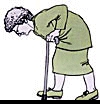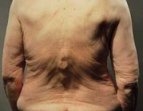Symptoms
Osteoporosis usually does not cause any symptoms for a long time – that is why it is also known as creeping bone loss. On the one hand, this is good (but only as long as there are actually no complaints) and, on the other hand, bad because one believes oneself to be in a false sense of security.
Just as a small hole in the gas tank does not cause any problems until the tank is completely empty and the car comes to a standstill, osteoporotic bone loss does not cause any pain at first. A broken forearm after a harmless fall or a broken rib, e.g. after a strong hug or a coughing attack caused by a cold, are often the first alarm signs that should make one think of osteoporosis.
Only the first vertebral collapse – which often appears out of the blue – then (if not always) leads to the typical symptom of osteoporosis, back pain. All other symptoms listed below are only found in advanced osteoporosis and should therefore be described as consequences rather than symptoms. They are therefore explained in more detail under the heading “Consequences”.
Back pain is practically the main symptom of osteoporosis. However, back pain can also have numerous other reasons such as disc damage, tension, rheumatism, wear and tear on the spine, scoliosis, etc. Often several causes are responsible for it at the same time. In the case of acute, severe back pain after the age of 50, especially if there are also significant risk factors for osteoporosis, there is always a suspicion of an acute vertebral collapse; this should therefore always serve as a reason for further diagnostic clarification.
While acute back pain usually subsides or disappears after a few weeks after a vertebral collapse, chronic back pain comes to the fore in advanced osteoporosis with several vertebral collapses. This chronic pain is mainly caused by the static changes in the entire spinal apparatus such as curvature (widow’s hump) and loss of size, which lead to shortening, hardening and tension in the muscles and tendons.
Thus, the osteoporotic back pain is usually not a bone pain, but primarily a muscle pain. In the case of rapidly progressing bone loss (fast-loser situation or high turnover situation), however, subsequent fractures of the trabeculae in the vertebral body can lead to (so-called subcortical) bleeding, which is then mainly due to stretching of the very pain-sensitive periosteum (Periosteum) cause actual “bone pain”.
An osteoporotic vertebral collapse is always associated with a more or less pronounced subsequent decrease in height of the affected vertebra. You can visualize this with a simple experiment. Take an empty shoebox and step on it. The lid is pressed in and the side walls folded in like an accordion. The shoebox will then be significantly smaller than before. The same happens when a vortex collapses (cover plate collapse). The body size will logically decrease by the same amount as the vertebral body loses height.
If there are several vertebral collapses, this often results in a considerable loss of size. Damaged intervertebral discs can also lead to a loss of size due to the reduced height of the defective intervertebral disc. However, if the loss of size is more than 4 cm in relation to the original height around the age of 18 (this is usually stated on the identity card), osteoporosis should also be considered as the cause.

In addition to the loss of size, advanced osteoporosis with several vertebral invasions also leads to an increased forward curvature of the entire spine (kyphosis). The result is the typical widow’s hump as we already know from the witch from Grimm’s fairy tale. However, this is not an inevitable sign of old age, as some still believe, but a logical consequence of (untreated) osteoporosis.

The loss of size in advanced osteoporosis often shows the so-called fir tree phenomenon. Because the skin does not “shrink” with it, of course, skin folds occur which, starting from the center of the back, run downwards to both sides and resemble the shape of a Christmas tree.
